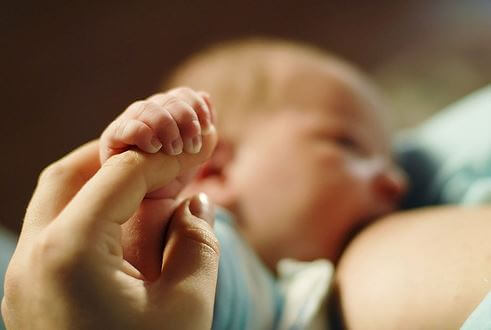What to Do When Breastfeeding Hurts

Many women decide to breastfeed thanks to the numerous benefits it provides for both mother and child. However, it’s not uncommon to hear some mothers say that breastfeeding hurts.
Although it’s typical to feel discomfort or sensitivity at first when the baby begins to suckle, it’s not normal for you to feel a lot of pain.
But if you’re going through that stage and you feel pain in your breasts, we encourage you to continue reading.
Here we’ll explain several reasons why many mothers say breastfeeding hurts and what you can do about it.
While motherhood involves moments that require effort on the part of the mother, suffering and pain should never be excessive.
Factors that make breastfeeding hurt
There are several reasons why some mothers say breastfeeding hurts. Among these are:
- The baby doesn’t latch on well to the nipple. When the newborn doesn’t hold the nipple well or suckle correctly, it often causes the nipple to hurt. In addition, cracks may appear that are painful and could cause bleeding.
- Short sublingual frenulum. Sometimes the baby has a short sublingual frenulum, also called ankyloglossia. This can cause the baby to not properly grasp the nipple and therefore consume the amount of milk he needs.

- Mastitis. This is usually the result of an infection that has seeped through open cracks. The symptoms are: the chest becomes hot and hurts a lot, chills, lethargy and fever.
- Fungus. This may be due to infection, or maybe the baby has a fungus in his mouth because he’s taken certain antibiotics. Among the symptoms are: a pink and moist chest with sharp pain.
- Mammary obstruction. This occurs when the milk ducts are blocked, causing a lot of pain. It can appear in only one breast. The skin becomes red, a white dot appears on the nipple and then a lump emerges.
- Mammary congestion. This occurs when the milk goes down after you start breastfeeding. It can cause the breasts to swell and hurt.
What can be done when breastfeeding hurts?
To make the time you spend breastfeeding your baby as painless and pleasant as possible, take note of the following tips:
- When breastfeeding, keep the baby’s head straight and wait for him to open his mouth wide. When he does, hold the breast with one hand and direct it to the baby’s palate. Make sure his mouth covers most of the areola.
If there was a vaccine with all the benefits of breastfeeding, parents would pay anything to buy it.
-Carlos Gonzalez-
- Breastfeed the baby every 2 hours. At night, you may have to wake him up to feed him, since he’ll often want to eat the same way he does during the day.
- If the baby drinks from only one breast, offer the other breast the next time you feed. That way you’ll avoid hurting just one.
- Change position when you breastfeed, as this way you can ease the discomfort and pain more easily.
- Avoid wearing bras that are too tight. Otherwise, this can cause an increase in pressure or friction on the skin.

- Wash your nipples with lukewarm water only. Don’t use soaps that contain alcohol or other chemicals, as they can create irritations and dry them.
- To avoid cracks in the nipple and cure them, the best treatment is breast milk itself.
- Try to stay calm and avoid stress.
In any case, your doctor will be the one who can best advise you on what to do if the pain becomes more and more intense.
While it’s true that motherhood involves moments that require effort on the part of the mother, suffering and pain should never be excessive.
Many women decide to breastfeed thanks to the numerous benefits it provides for both mother and child. However, it’s not uncommon to hear some mothers say that breastfeeding hurts.
Although it’s typical to feel discomfort or sensitivity at first when the baby begins to suckle, it’s not normal for you to feel a lot of pain.
But if you’re going through that stage and you feel pain in your breasts, we encourage you to continue reading.
Here we’ll explain several reasons why many mothers say breastfeeding hurts and what you can do about it.
While motherhood involves moments that require effort on the part of the mother, suffering and pain should never be excessive.
Factors that make breastfeeding hurt
There are several reasons why some mothers say breastfeeding hurts. Among these are:
- The baby doesn’t latch on well to the nipple. When the newborn doesn’t hold the nipple well or suckle correctly, it often causes the nipple to hurt. In addition, cracks may appear that are painful and could cause bleeding.
- Short sublingual frenulum. Sometimes the baby has a short sublingual frenulum, also called ankyloglossia. This can cause the baby to not properly grasp the nipple and therefore consume the amount of milk he needs.

- Mastitis. This is usually the result of an infection that has seeped through open cracks. The symptoms are: the chest becomes hot and hurts a lot, chills, lethargy and fever.
- Fungus. This may be due to infection, or maybe the baby has a fungus in his mouth because he’s taken certain antibiotics. Among the symptoms are: a pink and moist chest with sharp pain.
- Mammary obstruction. This occurs when the milk ducts are blocked, causing a lot of pain. It can appear in only one breast. The skin becomes red, a white dot appears on the nipple and then a lump emerges.
- Mammary congestion. This occurs when the milk goes down after you start breastfeeding. It can cause the breasts to swell and hurt.
What can be done when breastfeeding hurts?
To make the time you spend breastfeeding your baby as painless and pleasant as possible, take note of the following tips:
- When breastfeeding, keep the baby’s head straight and wait for him to open his mouth wide. When he does, hold the breast with one hand and direct it to the baby’s palate. Make sure his mouth covers most of the areola.
If there was a vaccine with all the benefits of breastfeeding, parents would pay anything to buy it.
-Carlos Gonzalez-
- Breastfeed the baby every 2 hours. At night, you may have to wake him up to feed him, since he’ll often want to eat the same way he does during the day.
- If the baby drinks from only one breast, offer the other breast the next time you feed. That way you’ll avoid hurting just one.
- Change position when you breastfeed, as this way you can ease the discomfort and pain more easily.
- Avoid wearing bras that are too tight. Otherwise, this can cause an increase in pressure or friction on the skin.

- Wash your nipples with lukewarm water only. Don’t use soaps that contain alcohol or other chemicals, as they can create irritations and dry them.
- To avoid cracks in the nipple and cure them, the best treatment is breast milk itself.
- Try to stay calm and avoid stress.
In any case, your doctor will be the one who can best advise you on what to do if the pain becomes more and more intense.
While it’s true that motherhood involves moments that require effort on the part of the mother, suffering and pain should never be excessive.
This text is provided for informational purposes only and does not replace consultation with a professional. If in doubt, consult your specialist.








